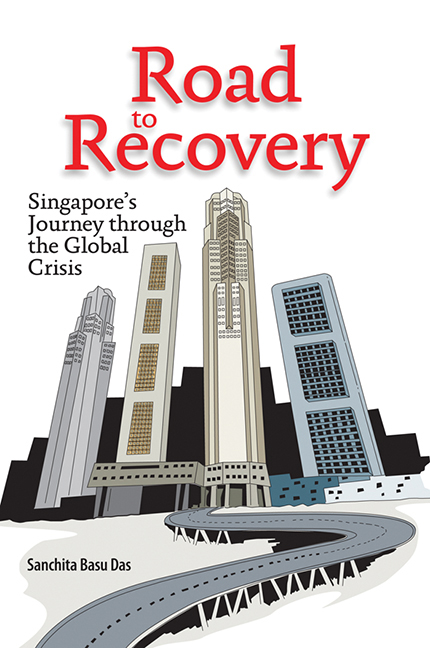Book contents
- Frontmatter
- Dedication
- Contents
- List of Tables
- List of Figures
- List of Boxes
- Foreword
- Acknowledgements
- Abbreviations
- 1 Introduction
- 2 Global Financial and Economic Crisis: Causes, Impact, and Policy Response
- 3 Impact of Global Economic Crisis on Singapore
- 4 Singapore's Policy Responses to the Global Economic Crisis
- 5 Singapore Economic Perspective and Future Policy Directions
- 6 Lessons Learnt
- Appendix I MAS Monetary Policy Statements
- Appendix II Key Budget FY2009 Initiatives
- Appendix III Summary of the ESC Key Recommendations
- Appendix IV Key Budget FY2010 Initiatives
- References
- Index
- About the Author
- Frontmatter
- Dedication
- Contents
- List of Tables
- List of Figures
- List of Boxes
- Foreword
- Acknowledgements
- Abbreviations
- 1 Introduction
- 2 Global Financial and Economic Crisis: Causes, Impact, and Policy Response
- 3 Impact of Global Economic Crisis on Singapore
- 4 Singapore's Policy Responses to the Global Economic Crisis
- 5 Singapore Economic Perspective and Future Policy Directions
- 6 Lessons Learnt
- Appendix I MAS Monetary Policy Statements
- Appendix II Key Budget FY2009 Initiatives
- Appendix III Summary of the ESC Key Recommendations
- Appendix IV Key Budget FY2010 Initiatives
- References
- Index
- About the Author
Summary
From 2004 to the middle of 2007, the world economy was growing strongly, world trade was burgeoning, inflation was low, liquidity in capital markets was abundant, the financial sector was providing remarkable returns, profitability was high, and asset prices were rising.
Yet, there were a few things that were disregarded by economists and financial experts. First, the real estate prices were rising astronomically, particularly in the United States, and a growing securitization business was facilitating a huge growth in credit. At the same time a major imbalance was surfacing. While one group of countries (Japan, China, and the oil-exporting countries) was saving too much, there were others like the United States, and Europe who were borrowing to finance consumption and investment. These developments were unsustainable and needed a very minor catalyst to cause havoc in the financial markets and the world economy.
In the end, it was the booming U.S. housing market which proved to be the nemesis. Low interest rates and abundant liquidity in the system encouraged banks and financial institutions, particularly in the United States, to lend to sub-prime borrowers. When the interest rates started to rise, a large proportion of borrowers began to default resulting in failure or huge losses by several large financial institutions. The U.S. crisis thereafter spread to other financial markets and spilled over to the real economy by end 2008, leading to recession in several economies across the globe.
Governments around the world were forced to act swiftly to avert the failure of their financial systems and arrest the decline of economic growth. Unprecedented steps in conducting monetary and fiscal policy were taken to fix the financial dislocation and the weakness in the economic system. Initially, central banks focused their attention on easing liquidity to alleviate tensions in the financial markets. They loosened the terms and availability of existing central bank facilities. Policy interest rates were cut by almost all countries.
- Type
- Chapter
- Information
- Road to RecoverySingapore's Journey through the Global Crisis, pp. 1 - 15Publisher: ISEAS–Yusof Ishak InstitutePrint publication year: 2010

